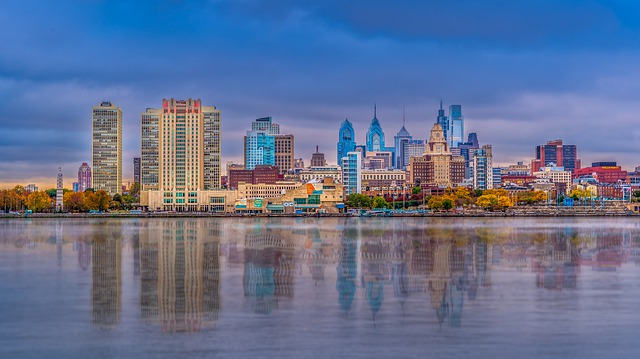By Tim Lambert
Early Philadelphia
In 1681 King Charles II granted a large amount of land in North America to a Quaker named William Penn. He established the colony of Pennsylvania. Penn sailed to North America in 1682. When he arrived he founded the city of Philadelphia.
By 1701 Philadelphia was a flourishing little town. In that year William Penn granted it a charter. In the 18th century, Philadelphia thrived on trade with the West Indies. Its population was swollen by German immigrants. Furthermore, Benjamin Franklin arrived in Philadelphia in 1723.
Bartram’s Garden was founded in 1728. A library was founded in Philadelphia in 1731 and a theater was built in 1766. Meanwhile, Pennsylvania Hospital opened in Philadelphia in 1751. In 1774 Tom Paine arrived in Philadelphia.
Meanwhile, tensions with Britain were growing. The First Continental Congress met in Philadelphia in 1774. The Second Continental Congress met there in 1775. Then in 1776, the Declaration of Independence was signed in Philadelphia. On 26 September 1777 during the War of Independence, British troops occupied Philadelphia. However, they did not hold it for long. The British withdrew from Philadelphia on 18 June 1778. The Constitutional Convention was held in Philadelphia in 1787. Meanwhile, Physick House was built in 1786. The First United States Bank was built in 1797.
In 1793 Philadelphia suffered a serious outbreak of yellow fever. Nevertheless, Philadelphia continued to thrive. By 1800 it was the largest town in the USA. In 1800 the population of Philadelphia was 41,000.
19th Century Philadelphia
In the early 19th century Philadelphia grew into a major manufacturing center. The population rose rapidly despite outbreaks of cholera in 1832 and 1849. By 1850 the population of Philadelphia had reached 121,000. Meanwhile, in 1801 Philadelphia gained a piped water supply and the Franklin Institute was founded in 1824. Then in 1836, the city gained a gas supply. However, in 1844 anti-immigrant riots broke out in Philadelphia. Then in 1854, Philadelphia was consolidated.
In the late 19th century the population of Philadelphia continued to boom. Immigrants flooded into the city and by 1900 its population had risen to nearly 1.3 million. Meanwhile in Philadelphia Zoo opened in 1874. In 1876 the World’s Fair was held in Philadelphia. Also in 1876, the Philadelphia Museum of Art opened.
Philadelphia in the 20th Century
Philadelphia City Hall was built in 1901.

Meanwhile, in the early 20th century many Italian immigrants came to Philadelphia. After the First World War, many African Americans moved to the city. Benjamin Franklin Parkway was completed in 1926 and Rodin Museum was built in 1929.
The first Pulaski Parade was held in Philadelphia in 1933. It was named after the Polish general Casimir Pulaski who fought in the American War of Independence.
However, Philadelphia, like the rest of the nation suffered badly in the Depression of the 1930s. Nevertheless, PSFS Building was built in 1932 and 30th Street Station opened in 1933. Philadelphia History Museum was founded in 1938 and when World War II came its industries boomed again.
However, in 1964 Philadelphia suffered a race riot. On the other hand, JFK Plaza was built in 1965.
In the late 20th century the old manufacturing industries in Philadelphia declined but service industries thrived. The African American Museum in Philadelphia opened in 1976. The same year, 1976 Valley Forge became a historical park. The Please Touch Museum was also founded in 1976. So was the National Museum of American Jewish History. The Philadelphia Convention Center opened in 1993.
Philadelphia gained new shopping malls. Sullivan Progress Plaza Shopping Center opened in 1968. The Court at King of Prussia opened in 1981. Philadelphia Mills opened in 1989.
Philadelphia has some notable modern buildings. One Liberty Place was built in 1987, CoreStates Center was built in 1996.
21st Century Philadelphia
In the 21st century, Philadelphia continued to thrive. The National Liberty Museum in Philadelphia opened in 2000 and the National Constitution Center opened in 2003. Comcast Center was built in 2008. The Museum of the American Revolution opened in 2017.
The population of Philadelphia peaked at nearly 2.1 million in 1950. In the late 20th century it declined. However recently it has begun to rise again.

In 2024 the population of Philadelphia was 1.6 million.
Last revised 2025